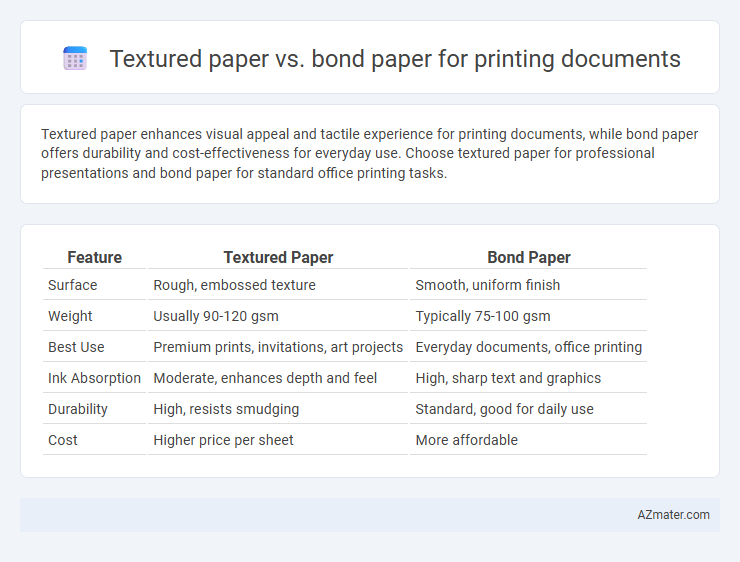Textured paper enhances visual appeal and tactile experience for printing documents, while bond paper offers durability and cost-effectiveness for everyday use. Choose textured paper for professional presentations and bond paper for standard office printing tasks.
Table of Comparison
| Feature | Textured Paper | Bond Paper |
|---|---|---|
| Surface | Rough, embossed texture | Smooth, uniform finish |
| Weight | Usually 90-120 gsm | Typically 75-100 gsm |
| Best Use | Premium prints, invitations, art projects | Everyday documents, office printing |
| Ink Absorption | Moderate, enhances depth and feel | High, sharp text and graphics |
| Durability | High, resists smudging | Standard, good for daily use |
| Cost | Higher price per sheet | More affordable |
Introduction to Printing Paper Types
Textured paper offers a tactile surface ideal for artistic prints, enhancing visual depth and ink absorption, while bond paper provides a smooth finish perfect for everyday document printing due to its durability and cost-effectiveness. Printing professionals often choose bond paper for its reliable performance in offices and high-volume printing environments, whereas textured paper is favored in creative projects requiring distinct aesthetic appeal. Understanding the specific requirements of the print job helps in selecting the appropriate paper type for optimal clarity and presentation.
What is Textured Paper?
Textured paper features a distinct surface pattern or raised design that enhances visual appeal and tactile experience, making it ideal for high-end printing projects like invitations and certificates. This type of paper generally has a heavier weight and a unique finish compared to bond paper, which is smooth and commonly used for everyday documents. Choosing textured paper can elevate the presentation quality but may require specific printers to handle its thickness and texture effectively.
What is Bond Paper?
Bond paper is a high-quality, durable paper commonly used for printing documents, letterheads, and official correspondence, known for its smooth texture and strength. It typically has a weight ranging from 16 to 24 pounds, providing a professional appearance and excellent ink absorption for clear, crisp text. Unlike textured paper, bond paper offers a uniform surface ideal for standard printing and writing applications.
Visual Appeal: Textured vs. Bond Paper
Textured paper offers a distinctive tactile feel and a sophisticated look that enhances visual appeal, making documents appear more elegant and professional. Bond paper, smooth and bright, provides a clean and sharp surface that ensures high-quality printing with crisp text and images. Choosing between textured and bond paper depends on whether a refined, artistic finish or a clear, standard presentation better suits the document's purpose.
Print Quality Comparison
Textured paper offers a unique surface that enhances tactile appeal and can improve the appearance of certain artistic prints, but it may cause ink to spread unevenly, resulting in less sharp text and images compared to bond paper. Bond paper, designed with smooth fibers and consistent weight, provides superior print quality for documents by ensuring crisp, clear text and precise image reproduction. For professional document printing, bond paper remains the optimal choice due to its reliable ink absorption and high-quality finish.
Durability and Strength
Textured paper offers enhanced durability and strength due to its thicker fibers and embossed surface, making it resistant to tearing and ideal for high-quality prints. Bond paper, commonly used for everyday printing, has a smoother surface but lower durability, prone to creasing and wear with frequent handling. For documents requiring longevity and professional presentation, textured paper provides superior structural integrity compared to bond paper.
Cost Analysis: Textured vs. Bond Paper
Textured paper typically incurs higher costs than bond paper due to its specialized manufacturing process and premium feel. Bond paper is more cost-effective for high-volume printing projects and standard documents, offering durability and affordability. Choosing between textured and bond paper depends on budget constraints and the intended impact of the printed material.
Best Use Cases for Textured Paper
Textured paper excels in printing high-quality invitations, certificates, and artistic prints where tactile feel and visual depth enhance presentation. Its surface irregularities add sophistication to formal documents and creative projects, making it ideal for branding materials and personalized stationery that require a luxurious, unique touch. Bond paper, by contrast, suits everyday printing needs with its smooth finish and cost-effectiveness, but lacks the aesthetic appeal that textured paper provides.
Best Use Cases for Bond Paper
Bond paper offers superior strength and durability, making it ideal for high-volume printing tasks such as office documents, reports, and official correspondence. Its smooth finish ensures clear, crisp text and graphics reproduction, enhancing readability and professionalism. This paper type excels in everyday printing where cost-effectiveness and reliability are essential, outperforming textured paper in consistency and ink absorption.
Choosing the Right Paper for Your Documents
Choosing the right paper for your documents depends on the purpose and desired finish; textured paper offers a tactile, premium feel ideal for invitations or presentations, while bond paper is best suited for everyday printing with its smooth surface and cost-effectiveness. Textured paper enhances visual appeal and adds sophistication but may cause ink to bleed or smudge slightly, making it less suitable for high-volume printing. Bond paper provides consistent print quality and durability, ensuring professional results for reports, letters, and standard office documents.

Infographic: Textured paper vs Bond paper for Printing Document
 azmater.com
azmater.com